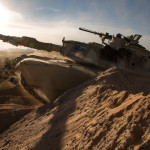This Motor’s a GEM. Northrop Grumman’s 63-inch diameter, extended length Graphite Epoxy Motor 63XL (GEM 63XL) is to debut on the first flight of United Launch Alliance’s (ULA) Vulcan Centaur rocket on Jan. 8. ULA is a joint venture between Lockheed Martin and Boeing. The 72-foot-long GEM 63XL is the longest monolithic solid rocket booster (SRB) “ever produced for flight,” as the GEM 63XL is six feet longer than its forebear, the GEM 63, Northrop Grumman said. “Manufacturing and casting the GEM 63XL as a single piece makes the motors more reliable and efficient by reducing joints, hardware and overall mass,” the company said. “This is crucial for an SRB of this length that can deliver over 463,000 pound of thrust to enhance the capabilities of rockets launching the nation’s most critical payloads.” Solid rocket motors, particularly smaller ones for munitions, look to be a new area for defense competition in a field dominated by Northrop Grumman and L3Harris.
…85 Percent. ULA said on Jan. 5 that the forecast for Jan. 8 shows “an 85 percent chance of favorable weather conditions” at Cape Canaveral, Fla., for the Vulcan Centaur launch on its first certification mission (Cert-1). The mission includes two payloads—Peregrine Lunar Lander/Peregrine Mission One for Astrobotic as part of NASA’s Commercial Lunar Payload Services initiative to the lunar surface and the Celestis Memorial Spaceflights deep space Voyager mission known as the Enterprise Flight.
Fourth Star. Newly-minted Air Force Gen. James Slife received his fourth star on Dec. 29 at Joint Base Anacostia-Bolling, D.C., in a ceremony in which Chairman of the Joint Chiefs of Staff Air Force Gen. Charles Q. Brown administered the oath of office to Slife. The latter became the Air Force’s vice chief of staff under Air Force Chief of Staff Gen. David Allvin last month. Slife has more than 3,100 flight hours in the MH-53 helicopter and the MQ-1 drone among other aircraft, the Air Force said, and served most recently as the Air Force’s deputy chief of staff for operations after heading Air Force Special Operations Command.
Anduril Award. The Air Force in late December awarded Anduril Industries a $31.1 million contract for the company’s Wide-Area Infrared System for Persistent Surveillance (WISP) to include counter-drone and counter-intrusion capabilities for base protection at Edwards AFB, Calif. Anduril will also provide its Lattice operating system, a command and control platform that enables autonomous operations. WISP is a passive, 360-degree imaging system that includes an infrared imager and artificial intelligence and can detect Group 1 and 2 UAS out to five and 13 kilometers, respectively, and dismounted operators and ground vehicles out to five and 15 kilometers respectively, the company says. The Air Force award announcement said the SkyFence solution includes sensor fusion and AI that will be used by the 412th Test Wing for situational awareness and base protection. The Air Force obligated $1.7 million initially under the four-year contract.
DIB Consortium. The Defense Department’s Washington Headquarters Services last week awarded Advanced Technology International a $22.1 million contract to manage the new Defense Industrial Base Consortium (DIBC), whose “mission is to coalesce and award project agreements that expand the DIB, while developing and maintaining expertise in the following DIB sectors and subsectors” to include kinetic capabilities in hypersonics, energy storage and batteries, castings and forgings, microelectronics, critical chemicals and minerals, small unmanned aerial systems, rare Earth elements, critical materials, the submarine and space industrial bases, and biomanufacturing, according to the Jan. 4 contract notice. The contract is in support of the DoD’s Industrial Base Policy office and in particular the Manufacturing, Capability Expansion, and Investment Prioritization Directorate that is working to strengthen the defense industrial base, including the supply chain. DoD, through ATI, plans to issue project agreements with DIBC members using authorities for prototypes and follow-on production.
Synthetic ML Data. The Department of Homeland Security Science and Technology Directorate is seeking solutions to generate synthetic data that model real life patterns to allow the department to train machine learning (ML) models when real-world data is not available, or if obtaining such data would pose privacy and security risks. The solicitation was issued through the Silicon Valley Innovation Program (SVIP) and seeks solutions with capabilities to support structured and unstructured data types, verify data fidelity, artificial generation of synthetic data using techniques to understand the shape and patterns of real data, and more. “It is crucial for DHS to effectively navigate today’s complex privacy landscape and employ innovative ideas and next generation technology techniques to do so,” said Melissa Oh, managing director of the SVIP. “The ability to generate synthetic data at scale is necessary to protect and preserve data privacy, as well as safeguard civil rights and liberties.”
NAVSEA Change. Vice Adm. James Downey assumed command of Naval Sea Systems Command (NAVSEA) from Rear Adm. Thomas Anderson during a change-of-command ceremony on Jan. 3. Anderson served as acting NAVSEA commander starting in September when former NAVSEA head Vice Adm. WIlliam Galinis retired. Anderson took over while Sen. Tommy Tuberville (R-Ala.) blocked Downey’s confirmation along with hundreds of other officials. Downey now serves as the 46th commander of NAVSEA after previously serving as program executive officer for aircraft carriers from 2019 to July 2023. Downey was assigned as Special Assistant to the Assistant Secretary of the Navy for Research, Development and Acquisition while waiting for the hold to be lifted.
SSN-762. The Navy recently awarded HII a $284 million modification to complete the engineered overhaul of the USS Columbus (SSN-762) Los Angeles-class attack submarine. The Defense Department announced the contract on Jan. 4 with the award occurring on Dec. 21. The contract includes options that, if exercised, will raise the total value to over$300 million. Work will occur at HII’s facility in Newport News, Va., and is expected to be finished by December 2025.
Houthi USV. The Pentagon said Houthi forces in Yemen attempted to launch a one-way attack with an Unmanned Surface Vessel (USV) on Jan. 4. In a press briefing, Vice Adm. Brad Cooper, commander of Naval Forces Central Command, said the USV was launched from Houthi territory in Yemen out about 15 miles into dense international maritime shipping lanes before it exploded, hitting no vessels. Cooper said the U.S. was “within a couple of miles of ships operating their merchant ships and U.S. Navy ships. And we all watched as it exploded.” Cooper said while there were no casualties, “the introduction of a one-way attack USV is of concern.”
…Small Vessel. Cooper called the Houthi USV a “low-profile unmanned surface vessel, not the Saildrone that you may have seen here in Bahrain,” as part of U.S. exercises in the region. He said it was packed with explosives and characterizes this as “the use of a new capability.” He added that while the U.S. has seen Houthi forces employ USVs before, this is the first time in this manner since hostilities related to Israel’s war in Gaza started over the last several months. He said since Nov. 18 there have been 15 attacks on merchant vessels transiting the southern Red Sea and Gulf of Aden.
Ukraine Aid. John Kirby, spokesman for the White House National Security Council, has said the Biden administration would “absolutely prioritize” air defense capabilities for Ukraine if Congress approves the pending supplemental funding package to continue security assistance efforts. Kirby’s comment follows the White House and Pentagon’s recent confirmation that the $250 million weapons package aid for Ukraine approved on Dec. 27 would be the last without additional funding from Congress. “As you heard us say as we went into the holidays here, we have no more replenishment funds and so, right now, I’m not anticipating any new [Presidential Drawdown Authority] (PDA) announcements, in terms of new capabilities, which is why we will continue working closely with Congress and urge them to pass the supplemental,” Air Force Maj. Gen. Patrick Ryder, the Pentagon press secretary, told reporters on Jan. 4. While Ryder noted there is “roughly” $4.2 billion remaining in PDA, the Pentagon has exhausted replenishment funds to replace stockpiles of weapons provided from current inventories.
NATO/Stinger FMS. The State Department on Dec. 22 approved a potential $780 million foreign military sale with the NATO Support and Procurement Agency (NSPA) for Stinger missiles. The NSPA is pursuing the FMS case to buy 940 RTX-built Stinger short-range air defense missiles on behalf of Germany, Italy and the Netherlands, according to the Defense Security Cooperation Agency. “The proposed sale will improve the air defense capabilities of these three NATO Allies. They will use the system to defend their territorial integrity and to promote regional stability. The proposed sale supports NATO’s goal of improving national and territorial defense as well as improving interoperability with U.S. and NATO forces,” the DSCA said in a statement.
C-17 Support. The State Department also approved a possible $150 million FMS case with the NSPA for Boeing C-17 airlifter maintenance. The NATO agency is acting as the lead to “buy contractor logistics support for the C-17 Strategic Airlift Capability program,” according to the DSCA. “The proposed sale will improve NATO’s capability to meet current and future threats by improving and maintaining a flexible strategic airlift capability. The multinational Heavy Airlift Wing already has C-17s in its inventory and will have no difficulty absorbing these additional services into its armed services,” the DSCA said in a statement.













